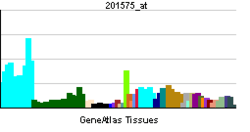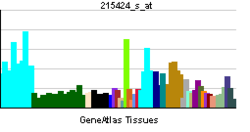SNW1
SNW domain-containing protein 1 is a protein that in humans is encoded by the SNW1 gene.[1][2][3]
This gene, a member of the SNW gene family, encodes a coactivator that enhances transcription from some Pol II promoters. This coactivator can bind to the ligand-binding domain of the vitamin D receptor and to retinoid receptors to enhance vitamin D-, retinoic acid-, estrogen-, and glucocorticoid-mediated gene expression. It can also function as a splicing factor by interacting with poly(A)-binding protein 2 to directly control the expression of muscle-specific genes at the transcriptional level. Finally, the protein may be involved in oncogenesis since it interacts with a region of SKI oncoproteins that is required for transforming activity.[3]
Interactions
SNW1 has been shown to interact with Histone deacetylase 2,[4] SKI protein,[5][6][7] Retinoblastoma protein,[8] PABPN1,[9] CIR,[4] RBPJ,[4][10] Nuclear receptor coactivator 1,[11] Nuclear receptor co-repressor 2,[4][10] Calcitriol receptor,[2][11] Mothers against decapentaplegic homolog 3,[7] NOTCH1[10][12] and Mothers against decapentaplegic homolog 2.[7]
References
- ↑ Folk P, Puta F, Krpejsova L, Blahuskova A, Markos A, Rabino M, Dottin RP (January 1997). "The homolog of chromatin binding protein Bx42 identified in Dictyostelium". Gene 181 (1–2): 229–31. doi:10.1016/S0378-1119(96)00483-0. PMID 8973337.
- ↑ 2.0 2.1 Baudino TA, Kraichely DM, Jefcoat SC Jr, Winchester SK, Partridge NC, MacDonald PN (August 1998). "Isolation and characterization of a novel coactivator protein, NCoA-62, involved in vitamin D-mediated transcription". J Biol Chem 273 (26): 16434–41. doi:10.1074/jbc.273.26.16434. PMID 9632709.
- ↑ 3.0 3.1 "Entrez Gene: SNW1 SNW domain containing 1".
- ↑ 4.0 4.1 4.2 4.3 Zhou, S; Fujimuro M; Hsieh J J; Chen L; Hayward S D (February 2000). "A Role for SKIP in EBNA2 Activation of CBF1-Repressed Promoters". J. Virol. (UNITED STATES) 74 (4): 1939–47. doi:10.1128/JVI.74.4.1939-1947.2000. ISSN 0022-538X. PMC 111672. PMID 10644367.
- ↑ Prathapam, T; Kühne C; Hayman M; Banks L (September 2001). "Ski interacts with the evolutionarily conserved SNW domain of Skip". Nucleic Acids Res. (England) 29 (17): 3469–76. doi:10.1093/nar/29.17.3469. PMC 55893. PMID 11522815.
- ↑ Dahl, R; Wani B; Hayman M J (March 1998). "The Ski oncoprotein interacts with Skip, the human homolog of Drosophila Bx42". Oncogene (ENGLAND) 16 (12): 1579–86. doi:10.1038/sj.onc.1201687. ISSN 0950-9232. PMID 9569025.
- ↑ 7.0 7.1 7.2 Leong, G M; Subramaniam N; Figueroa J; Flanagan J L; Hayman M J; Eisman J A; Kouzmenko A P (May 2001). "Ski-interacting protein interacts with Smad proteins to augment transforming growth factor-beta-dependent transcription". J. Biol. Chem. (United States) 276 (21): 18243–8. doi:10.1074/jbc.M010815200. ISSN 0021-9258. PMID 11278756.
- ↑ Prathapam, Tulasiram; Kühne Christian; Banks Lawrence (Dec 2002). "Skip interacts with the retinoblastoma tumor suppressor and inhibits its transcriptional repression activity". Nucleic Acids Res. (England) 30 (23): 5261–8. doi:10.1093/nar/gkf658. PMC 137971. PMID 12466551.
- ↑ Kim, Y J; Noguchi S; Hayashi Y K; Tsukahara T; Shimizu T; Arahata K (May 2001). "The product of an oculopharyngeal muscular dystrophy gene, poly(A)-binding protein 2, interacts with SKIP and stimulates muscle-specific gene expression". Hum. Mol. Genet. (England) 10 (11): 1129–39. doi:10.1093/hmg/10.11.1129. ISSN 0964-6906. PMID 11371506.
- ↑ 10.0 10.1 10.2 Zhou, S; Fujimuro M; Hsieh J J; Chen L; Miyamoto A; Weinmaster G; Hayward S D (April 2000). "SKIP, a CBF1-Associated Protein, Interacts with the Ankyrin Repeat Domain of NotchIC To Facilitate NotchIC Function". Mol. Cell. Biol. (UNITED STATES) 20 (7): 2400–10. doi:10.1128/MCB.20.7.2400-2410.2000. ISSN 0270-7306. PMC 85419. PMID 10713164.
- ↑ 11.0 11.1 Zhang, C; Baudino T A; Dowd D R; Tokumaru H; Wang W; MacDonald P N (November 2001). "Ternary complexes and cooperative interplay between NCoA-62/Ski-interacting protein and steroid receptor coactivators in vitamin D receptor-mediated transcription". J. Biol. Chem. (United States) 276 (44): 40614–20. doi:10.1074/jbc.M106263200. ISSN 0021-9258. PMID 11514567.
- ↑ Beatus, P; Lundkvist J; Oberg C; Pedersen K; Lendahl U (June 2001). "The origin of the ankyrin repeat region in Notch intracellular domains is critical for regulation of HES promoter activity". Mech. Dev. (Ireland) 104 (1–2): 3–20. doi:10.1016/S0925-4773(01)00373-2. ISSN 0925-4773. PMID 11404076.
Further reading
- Dahl R, Wani B, Hayman MJ (1998). "The Ski oncoprotein interacts with Skip, the human homolog of Drosophila Bx42". Oncogene 16 (12): 1579–86. doi:10.1038/sj.onc.1201687. PMID 9569025.
- Zhou S, Fujimuro M, Hsieh JJ et al. (2000). "A Role for SKIP in EBNA2 Activation of CBF1-Repressed Promoters". J. Virol. 74 (4): 1939–47. doi:10.1128/JVI.74.4.1939-1947.2000. PMC 111672. PMID 10644367.
- Zhou S, Fujimuro M, Hsieh JJ et al. (2000). "SKIP, a CBF1-Associated Protein, Interacts with the Ankyrin Repeat Domain of NotchIC To Facilitate NotchIC Function". Mol. Cell. Biol. 20 (7): 2400–10. doi:10.1128/MCB.20.7.2400-2410.2000. PMC 85419. PMID 10713164.
- Leong GM, Subramaniam N, Figueroa J et al. (2001). "Ski-interacting protein interacts with Smad proteins to augment transforming growth factor-beta-dependent transcription". J. Biol. Chem. 276 (21): 18243–8. doi:10.1074/jbc.M010815200. PMID 11278756.
- Kim YJ, Noguchi S, Hayashi YK et al. (2001). "The product of an oculopharyngeal muscular dystrophy gene, poly(A)-binding protein 2, interacts with SKIP and stimulates muscle-specific gene expression". Hum. Mol. Genet. 10 (11): 1129–39. doi:10.1093/hmg/10.11.1129. PMID 11371506.
- Beatus P, Lundkvist J, Oberg C et al. (2001). "The origin of the ankyrin repeat region in Notch intracellular domains is critical for regulation of HES promoter activity". Mech. Dev. 104 (1–2): 3–20. doi:10.1016/S0925-4773(01)00373-2. PMID 11404076.
- Zhou S, Hayward SD (2001). "Nuclear Localization of CBF1 Is Regulated by Interactions with the SMRT Corepressor Complex". Mol. Cell. Biol. 21 (18): 6222–32. doi:10.1128/MCB.21.18.6222-6232.2001. PMC 87339. PMID 11509665.
- Zhang C, Baudino TA, Dowd DR et al. (2001). "Ternary complexes and cooperative interplay between NCoA-62/Ski-interacting protein and steroid receptor coactivators in vitamin D receptor-mediated transcription". J. Biol. Chem. 276 (44): 40614–20. doi:10.1074/jbc.M106263200. PMID 11514567.
- Prathapam T, Kühne C, Hayman M, Banks L (2001). "Ski interacts with the evolutionarily conserved SNW domain of Skip". Nucleic Acids Res. 29 (17): 3469–76. doi:10.1093/nar/29.17.3469. PMC 55893. PMID 11522815.
- Jurica MS, Licklider LJ, Gygi SR et al. (2002). "Purification and characterization of native spliceosomes suitable for three-dimensional structural analysis". RNA 8 (4): 426–39. doi:10.1017/S1355838202021088. PMC 1370266. PMID 11991638.
- Wardell SE, Boonyaratanakornkit V, Adelman JS et al. (2002). "Jun Dimerization Protein 2 Functions as a Progesterone Receptor N-Terminal Domain Coactivator". Mol. Cell. Biol. 22 (15): 5451–66. doi:10.1128/MCB.22.15.5451-5466.2002. PMC 133955. PMID 12101239.
- Prathapam T, Kühne C, Banks L (2002). "Skip interacts with the retinoblastoma tumor suppressor and inhibits its transcriptional repression activity". Nucleic Acids Res. 30 (23): 5261–8. doi:10.1093/nar/gkf658. PMC 137971. PMID 12466551.
- Strausberg RL, Feingold EA, Grouse LH et al. (2003). "Generation and initial analysis of more than 15,000 full-length human and mouse cDNA sequences". Proc. Natl. Acad. Sci. U.S.A. 99 (26): 16899–903. doi:10.1073/pnas.242603899. PMC 139241. PMID 12477932.
- Petersen HH, Hilpert J, Militz D et al. (2003). "Functional interaction of megalin with the megalinbinding protein (MegBP), a novel tetratrico peptide repeat-containing adaptor molecule". J. Cell. Sci. 116 (Pt 3): 453–61. doi:10.1242/jcs.00243. PMID 12508107.
- Heilig R, Eckenberg R, Petit JL et al. (2003). "The DNA sequence and analysis of human chromosome 14". Nature 421 (6923): 601–7. doi:10.1038/nature01348. PMID 12508121.
- Barry JB, Leong GM, Church WB et al. (2003). "Interactions of SKIP/NCoA-62, TFIIB, and retinoid X receptor with vitamin D receptor helix H10 residues". J. Biol. Chem. 278 (10): 8224–8. doi:10.1074/jbc.C200712200. PMID 12529369.
- Zhang C, Dowd DR, Staal A et al. (2003). "Nuclear coactivator-62 kDa/Ski-interacting protein is a nuclear matrix-associated coactivator that may couple vitamin D receptor-mediated transcription and RNA splicing". J. Biol. Chem. 278 (37): 35325–36. doi:10.1074/jbc.M305191200. PMID 12840015.
- Leong GM, Subramaniam N, Issa LL et al. (2004). "Ski-interacting protein, a bifunctional nuclear receptor coregulator that interacts with N-CoR/SMRT and p300". Biochem. Biophys. Res. Commun. 315 (4): 1070–6. doi:10.1016/j.bbrc.2004.02.004. PMID 14985122.

